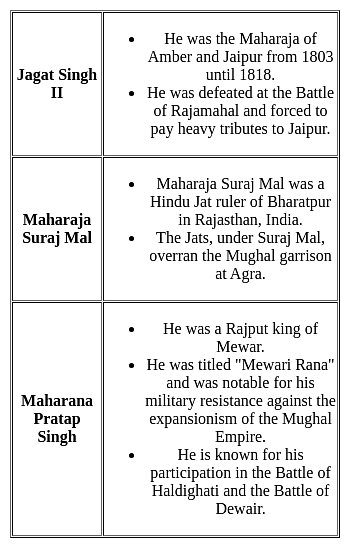UGC NET Paper 2 History Mock Test - 9 - UGC NET MCQ
30 Questions MCQ Test - UGC NET Paper 2 History Mock Test - 9
Which of the following provisions were not offered under Wavell Plan?
Which of the following statement is/are correct?
- Jahandar Shah II encouraged Jazia System.
- Nadir Shah of Persia invaded with the help of Sadat Khan who defeated the Mughal army at the Battle of Buxar.
- Marathas under Baji Rao, for the first in Mughal history, raided in Delhi.
Select the correct code from below.
| 1 Crore+ students have signed up on EduRev. Have you? Download the App |
In Chola administration, ________ was the assembly in the villages which were inhabited predominantly by the Brahmanas.
Arrange the following Buddhist sects in chronological order:
(i) Hinayanists and Mahayanists
(ii) Sthaviravadins and Mahasanghikas
(iii) Vajrayanists
(iv) Sarvastivadins
Select the answer from the codes given below:
In which year there was a mutiny by the sepoys at Vellore due to the replacement of the turban they wore, by a leather cockade.
Who among the following strongly opposed the interference of the Ulemas in the affairs of the state?
i. Balban
ii. Alauddin Khilji
iii. Muhammad-bin-Tughlaq
iv. Firoze Shah Tughlaq
Consider the following statements regarding Cave architecture in India:
1. Barabar caves are carved out from monolithic granite rock.
2. The walls of Lomas Rishi caves comprises inscriptions of Ashoka and various other motifs.
3. According to the inscription found at the entrance of Sudama cave, Chandragupta Maurya dedicated the cave to Ajivikas.
Which of the statements given above is/are not correct?
During the Indian Freedom Struggle, who among the following proposed that Swaraj should be defined as complete independence free from all foreign control?
With reference to the system of ‘Subsidiary Aliances’, consider the following statements.
1) Under this system, the ruler of the allying Indian state was to be provided with the British defence forces only when required.
2) The ruler also sometimes ceded part of his territory instead of paying annual subsidy.
3) The ruler could employ any European in his service at his court.
Choose the incorrect answer
Which of the following pairs is not correctly matched?

Which of the following is/are correctly matched in the context of medieval history?

With reference to the difference between the Social structure of the Early Vedic Period and the Later Vedic Period which of the following statements is/are correct?
1. Women in the Early Vedic Period were allowed to take part in Sabha and Samiti while women in the Later Vedic Period were prohibited to attend public assemblies like Sabha and Samiti.
2. Child Marriage was common in the Early Vedic Period while it was not observed during the Later Vedic Period.
3. The society was divided into four divisions in decreasing social ranking were- Brahmanas, Kshatriyas, Vaishyas, and Shudras during both the Vedic Period.
Consider the following statements regarding Butler Committee:
1. The Butler Committee was set up to examine the nature of the relationship between the princely states and government.
2. Butler commission recommended that States should be handed over to an Indian Government in British India
Which of the statements given above is/are correct?Which among the following emperors introduced the two laws of Vyavahar Samta and Danda Samata?
Which of the following succeeded Mauryas in the Deccan and in central India?
Consider the following statements:
- Main deity is Lord Shiva.
- There is also a Nandi shrine.
- It was built during the Rashtrakuta phase.
- It is completely made in Dravida style
- It is carved out of a portion of a hill.
The statements given above are referring to which one of the following temples?
Nimar festival is organized every year in Madhya Pradesh at-
Choose the incorrect pair:
- Charter Act of 1833: The recruitment of civil service was thrown open to Indians also.
- Charter Act of 1853: It made Governor-General of Bengal as the Governor-General of India.
King Charles II handed over the Bombay Island to the company in which year?
Consider the following statements about the Government of India Act 1935:
- The membership of Central Legislative Assembly and the Council of State was increased
- Provincial autonomy was introduced into the provinces
- The Dyarchy system was transferred from provinces to the centre.
Which of the above statements is/are correct?






















